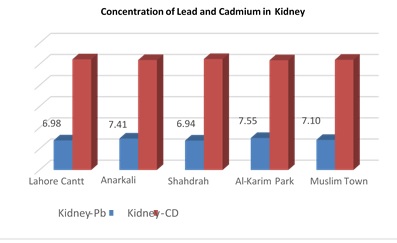Detection and Estimation of Heavy Metals in Broiler Meat Available in Lahore, Pakistan
Abstract
 Abstract Views: 362
Abstract Views: 362
Cadmium (Cd) and lead (Pb) are toxic environmental pollutants. These heavy metals create serious health issues in consumers. The current study aimed to identify the quantity of lead and cadmium in broiler chicken, including in its liver and kidneys, since the demand for chicken meat as a food source is increasing day by day. Forty (40) broiler chickens were purchased from the various markets of Lahore, Pakistan including the markets of Sadar Cantt area, Shahdra, Alkarim park, Anarkali, and Muslim town. These chickens were collected, processed, and analyzed to determine the levels of lead and cadmium in their internal organs (liver and kidneys) using atomic absorption spectrophotometer. This process was carried out in the laboratory of PCSIR after the digestion of all samples via nitric acid (HNOз) and hydrogen peroxide using the wet digestion method. The range of the mean concentration of lead (4.50 - 8.50ug /g) and cadmium (25.00 - 27.75 ug/g) in the internal organs of broiler chicken exceeded the permissible level of 0.05% recommended by the World Health Organization (WHO). ANOVA analysis revealed that the presence of heavy metals was not significant in the internal organs of broiler meat collected from different areas of Lahore, since the p-value was greater than the significance level (p > 0.05). Hence, heavy metal concentrations were recorded as above the permissible level recommended by the WHO.
Downloads
References
Mariam I, Iqbal S, Nagra SA. Distribution of some trace and macrominerals in beef, mutton and poultry. Int. J. Agric. Biol. 2004;6(5):816-820.
Hadyait MA, Qayyum A, Bhatti EM, Salim S, Ali A, Shahzadi M. Estimation of heavy metals in liver, gizzard, breast and thigh muscles of broiler chicken in different area of Lahore by ICP- OES. PSM Vet Res. 2005;3(1):10-14.
Gorissen SH, Horstman AM, Franssen R, et al. Habituation to low or high protein intake does not modulate basal or postprandial muscles protein synthesis rates: a randomized trial. Am J Clin Nutr. 2017;105(2):332-342. https://doi.org/10.3945/ajcn.115.129924
Kralik G, Kralik Z, Grčević M, Hanžek D. Quality of chicken meat. In: Yücel B, Taşkin T, Animal husbandry and nutrition, InTech Open; 2018: 63.
Abdel-Salam NM, Ahmed, Basir A, et al. Distribution of heavy metals in the liver, kidney, heart, pancreas, and meat of cow, buffalo, goat, sheep and chicken from Kohat market Pakistan. Life Sci J. 2013;10(7s):937-940.
Asegbeloyin JN, Onyimonyi AE, Ujam OT, Ukwueze NN, Ukoha PO. Assessment of toxic trace metals in selected fish species and parts of domestic animals. Pak J Nutr. 2010;9(3):213-215.
Akan JC, Abdulrahman FI, Sodipo OA, Chiroma YA. Distribution of heavy metals in the liver, kidney, and meat of beef, mutton, caprine, and chicken from Kasuwan Shanu Market in Maiduguri Metropolis, Borno State, Nigeria. Res J Appl Sci Eng Technol. 2010;2(8):743-748.
Alturiqi AS, Albedair LA. Evaluation of some heavy metals in certain fish, meat, and meat products in Saudi Arabian markets. Egypt J Aquat Res. 2012;38(1):45-49. https://doi.org/10.1016/j.ejar.2012.08.003
John HH, Jeanne IR. Food additives, contaminants and natural toxins. Mod Nutr Health Dis. 2004;8:1597-1598.
Koréneková B, Skalická M, Nad P. Concentration of some heavy metals in cattle reared in vicinity of a metallurgic industry. Vet Arh. 2002;72(5):259-268.
Järup L, Berglund M, Elinder CG, Nordberg G, Vanter M. Health effects of cadmium exposure–a review of the literature and a risk estimate. Scand J Work Environ Health. 2008;4(1):1-51.
Hakeem A, Khan N, Khan S. A comparative Study of the Heavy Metals in the Meat of Chickens in Different Cities of Pakistan. A Review. Al-Nahrain J Sci. 2020;23(2):75-79.
Bakalli RI, Pesti GM, Ragland WL, Konjufca V. Dietary Copper in Excess of Nutritional Requirement Reduces Plasma and Breast Muscle Cholesterol of Chickens. Poult Sci. 1995;74(2):360-365. https://doi.org/10.3382/ps.0740360
Millar C, Bissonnette B, Humphreys RP. Cerebral arteriovenous malformations in children. Can J Anaesth. 2014;41(4):321-331. https://doi.org/10.1007/BF03009913
McLaughlin MJ, Parker DR, Clarke JM. Metals and micronutrients–food safety issues. Field Crops Res. 2009;60(1-2):143-163. https://doi.org/10.1016/S0378-4290(98)00137-3
Damerval C, Maurice A, Josse JM, de Vienne D. Quantitative trait loci underlying gene product variation: a novel perspective for analyzing regulation of genome expression. Genetics. 2016;137(1):289-301. https://doi.org/10.1093/genetics/137.1.289
Jin T, Nordberg M, Frech W, et al. Cadmium biomonitoring and renal dysfunction among a population environmentally exposed to cadmium from smelting in China (ChinaCad). Biometals. 2002;15(4):397-410. https://doi.org/10.1023/A:1020229923095
Flanagan PR, McLellan JS, Haist J, Cherian MG, Chamberlain MJ., Valberg LS. Increased dietary cadmium absorption in mice and human subjects with iron deficiency. Gastroenterology, 2008;74(5):841-846. https://doi.org/10.1016/0016-5085(78)90138-5
Imran R, Hamid A, Amjad R. Estimation of the heavy metal concentration in the poultry meat being produced in Kasur. J Bio Moreover Env Sci. 2015;7(4):62-75.
Järup L, Hellström L, Alfvén T, et al. Low-level exposure to cadmium and early kidney damages; the OSCAR study. Occup Environ Med. 2000;57(10):668-672. http://dx.doi.org/10.1136/oem.57.10.668

Copyright (c) 2022 Hira Salamat

This work is licensed under a Creative Commons Attribution 4.0 International License.
BSR follows an open-access publishing policy and full text of all published articles is available free, immediately upon publication of an issue. The journal’s contents are published and distributed under the terms of the Creative Commons Attribution 4.0 International (CC-BY 4.0) license. Thus, the work submitted to the journal implies that it is original, unpublished work of the authors (neither published previously nor accepted/under consideration for publication elsewhere). On acceptance of a manuscript for publication, a corresponding author on the behalf of all co-authors of the manuscript will sign and submit a completed the Copyright and Author Consent Form.









